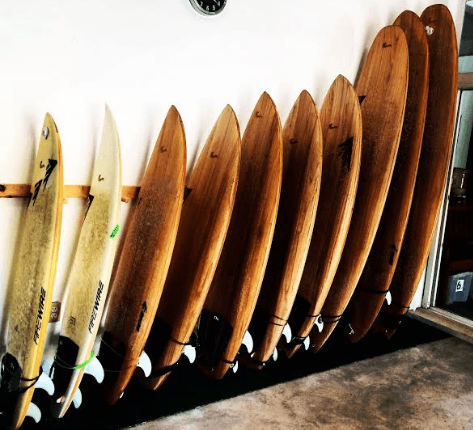How to pick my Surfboard?
Walking into a surf shop and picking a board can be very overwhelming but have no fear, we can help! There are many surfboard styles and sizes to pick from and all depending on your experience, type of waves, style of surfing and so much more. The most common shapes are listed below but there are many new styles/hybrids that can be difficult to group such as the Mini Simms so most surfers categorize them as “other”.
All sizes and styles from shortboards to longboards! Our new Firewires at Wildmex!
Thickness
-The thicker the board, the more float (volume) which means easier to paddle and stand up. However, a thinner board is lighter and keeps your contact point on the board closer to the water making a “livelier” feeling
Width
-The wider the board, the more stable and easier to surf. Although, the wider the board, the farther your feet will be from the rails when on a rail, which can make it tricky on steep or hollow waves; plus it adds more volume and makes it harder to duck dive.
Length
-The longer the board, the easier to paddle and catch waves. A longer board is very stable compared to a shorter board and easier to learn on. A shortboard has more maneuverability. Longboards also have a longer “glide” which makes for slower and longer paddles meaning it is way faster and easier to paddle into a wave than shorter boards.
SURFBOARD DESIGNS
Foam board
Foam boards are great to learn and practice on until you can stand up and surf. Once you are comfortable surfing on the foam board, then you can progress to a hard top longboard. Foam boards are very soft, stable and float very well due to their thickness and width. They are safer than hard top surfboards due to soft fins and foam top.
Longboard
-Range from 8 to 12 feet
-Large volume (width, depth) easier to paddle and float
-Great for beginners, smooth surfers, relaxing, small waves
-Known for beautiful, chill surfing and nose riding also known as “hang ten”
-Surfing originated with classic longboards made from wood and ranged from 8 to 30 feet
–A longboard with a single fin allows the board to pivot turn nicely but it is harder to surf on steeper/hollower waves
Funboard
-Range from 6.6 to 8.6 feet
-Large volume (width, depth) easier to paddle and float
-Variety of nose and tail options but mainly rounded
-Elements from from shortboards and longboards
-Good option to transition to a shorter board from a longboard.
-Good all around board for beginners and intermediates
Hybrid
-A mix of different board styles such as longboard/shortboard or fish/shortboard
-Range from approximately 5 to 8 feet
-Usually surfed in smaller waves with any fin set up
-Generally wider and thicker than shortboards
Shortboard
-Allows surfers to push boundaries
-Quick to maneuverability
-Generally under 7 feet
-Thin, narrow and point for critical sections
-From 3 to 4 fin set up
Fish
-Short and stubby
-Works well with mushy waves
-Less rocker than a shortboard
-Developed from a kneeboard in 1967
-Paddles well and keeps speed in flat sections of waves
Gun
-Massive wave surfboard. Used in big wave locations
-Generally up to 10 feet length
-Designed for large drops and speed
-Resembles a short board but is long
In future blogs we will go into further detail about noses/tails, “other” categorized surfboards and so much more! Stay tuned!

